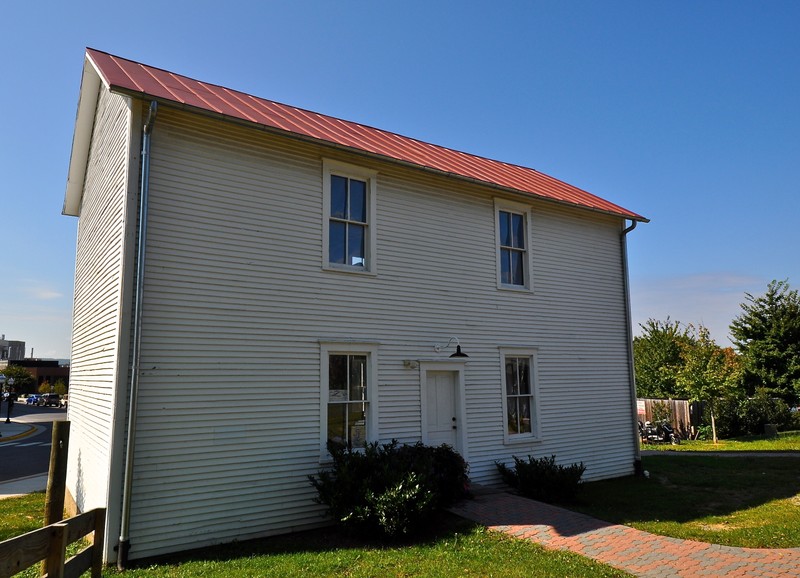St. Luke's & Old Fellows Hall
Introduction
Text-to-speech Audio
St. Luke's & Odd Fellows Hall, also known as Tadmore Light Lodge, No. 6184, is a historic Grand United Order of Odd Fellows meeting hall in Blacksburg, Virginia. The two-story framed structure served as the social center of the African-American community throughout the early- to mid-20th Century. It was added to the National Register of Historic Places and designated a Virginia Historic Landmark in 2005. Today, the hall is a museum stewarded by the Blacksburg Museum and Cultural Foundation; it can also be rented as meeting and event space.
Images
(2013) Odd Fellows Hall; image by Skye Marthaler - Own work, CC BY-SA 3.0, https://commons.wikimedia.org/w/index.php?curid=28768264

Backstory and Context
Text-to-speech Audio
St. Luke's & Odd Fellows Hall, also known as Tadmore Light Lodge, No. 6184, is a historic Grand United Order of Odd Fellows meeting hall. The two-story building is clad painted weatherboard siding and features a standing seam metal gable roof. It is the only remaining structure from New Town, an African-American neighborhood in Blacksburg, Virginia. New Town was established in the late 19th century and ceased to exist by the mid-1960s and 70s. It consisted of Gilbert Street and a small lane and was home to about 20 families.
Odd Fellows Hall was constructed in 1907 following the purchase of a small lot on the corner of Gilbert and Barger streets by members of the Odd Fellows. It is thought it was built from volunteer labor in a Greek Classical style. For more than 60 years, from its construction until the end of segregation, the hall served as a gathering place for the African-American community. Residents hosted social events including dances, fashion shows, bingo parties, mock weddings, ball games, and Easter egg hunts in the building. It also served as meeting space for the Order of St. Luke, the Busy Bee Society, and the Household of Ruth Lodge #5533 of the Grand United Order of Odd Fellows.
Following the end of segregation, the hall was used less as a social center and was rented as a workshop. Furthermore, construction and urban development in the 1970s saw the decline and disappearance of New Town as a predominantly African-American neighborhood. In 2004 and 2005, trustees appointed by the court negotiated an agreement with the Town of Blacksburg in order to preserve the hall. Also in 2005, the structure was designated on the Virginia Landmarks Registry and added to the National Register of Historic Places. The historic structure underwent restorations from 2009 to 2010.
Since 2012, the Blacksburg Museum & Cultural Foundation has administered the building—now a museum. The building is well-lit, houses an ample stage, and is available for rental as event space (see contact number). BM&CF runs two museums in the Blacksburg area, the other being the Alexander Black House & Cultural Center.
Odd Fellows Hall was constructed in 1907 following the purchase of a small lot on the corner of Gilbert and Barger streets by members of the Odd Fellows. It is thought it was built from volunteer labor in a Greek Classical style. For more than 60 years, from its construction until the end of segregation, the hall served as a gathering place for the African-American community. Residents hosted social events including dances, fashion shows, bingo parties, mock weddings, ball games, and Easter egg hunts in the building. It also served as meeting space for the Order of St. Luke, the Busy Bee Society, and the Household of Ruth Lodge #5533 of the Grand United Order of Odd Fellows.
Following the end of segregation, the hall was used less as a social center and was rented as a workshop. Furthermore, construction and urban development in the 1970s saw the decline and disappearance of New Town as a predominantly African-American neighborhood. In 2004 and 2005, trustees appointed by the court negotiated an agreement with the Town of Blacksburg in order to preserve the hall. Also in 2005, the structure was designated on the Virginia Landmarks Registry and added to the National Register of Historic Places. The historic structure underwent restorations from 2009 to 2010.
Since 2012, the Blacksburg Museum & Cultural Foundation has administered the building—now a museum. The building is well-lit, houses an ample stage, and is available for rental as event space (see contact number). BM&CF runs two museums in the Blacksburg area, the other being the Alexander Black House & Cultural Center.
Sources
"About St. Luke & Odd Fellow's Hall". BM&CF. Accessed February 5, 2015. http://Blacksburgmuseum.org/about/st-luke-and-old-fellows-hall/.
St. Luke and Odd Fellows Hall. Town of Blacksburg, VA. Accessed February 5, 2017. http://www.Blacksburg.gov/community/arts-and-culture/Blacksburg-museum-and-cultural-foundation/st-lu....
Odd Fellows Hall (Blacksburg, Virginia). Wikipedia - The Free Encyclopedia. Accessed February 5, 2017. https://en.wikipedia.org/wiki/Odd_Fellows_Hall_(Blacksburg,_Virginia).
St. Luke and Odd Fellows Hall. Town of Blacksburg, VA. Accessed February 5, 2017. http://www.Blacksburg.gov/community/arts-and-culture/Blacksburg-museum-and-cultural-foundation/st-lu....
Odd Fellows Hall (Blacksburg, Virginia). Wikipedia - The Free Encyclopedia. Accessed February 5, 2017. https://en.wikipedia.org/wiki/Odd_Fellows_Hall_(Blacksburg,_Virginia).
